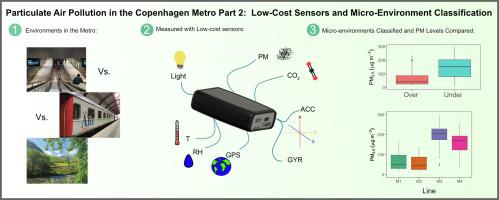Environment International ( IF 10.3 ) Pub Date : 2022-11-17 , DOI: 10.1016/j.envint.2022.107645 Hugo S Russell 1 , Niklas Kappelt 2 , Dafni Fessa 3 , Louise B Frederickson 1 , Evangelos Bagkis 4 , Pantelis Apostolidis 4 , Kostas Karatzas 4 , Johan A Schmidt 5 , Ole Hertel 6 , Matthew S Johnson 2

|
In this study fine particulate matter (PM2.5) levels throughout the Copenhagen metro system are measured for the first time and found to be times the roadside levels in Copenhagen. In this Part 2 article, low-cost sensor (LCS) nodes designed for personal-exposure monitoring are tested against a conventional mid-range device (TSI DustTrak), and gravimetric methods. The nodes were found to be effective for personal exposure measurements inside the metro system, with values of 0.8 at 1-min and 0.9 at 5-min time-resolution, with an average slope of 1.01 in both cases, in comparison to the reference, which is impressive for this dynamic environment. Micro-environment (ME) classification techniques are also developed and tested, involving the use of auxiliary sensors, measuring light, carbon dioxide, humidity, temperature and motion. The output from these sensors is used to distinguish between specific MEs, namely, being aboard trains travelling above- or under- ground, with 83 % accuracy, and determining whether sensors were aboard a train or stationary at a platform with 92 % accuracy. This information was used to show a 143 % increase in mean PM2.5 concentration for underground sections relative to overground, and 22 % increase for train vs. platform measurements. The ME classification method can also be used to improve calibration models, assist in accurate exposure assessment based on detailed time-activity patterns, and facilitate field studies that do not require personnel to record time-activity diaries.
中文翻译:

哥本哈根地铁中的颗粒物空气污染第 2 部分:低成本传感器和微环境分类
在这项研究中,首次测量了整个哥本哈根地铁系统的细颗粒物 (PM 2.5 ) 水平,发现倍于哥本哈根的路边水位。在本文的第 2 部分中,针对传统中档设备 (TSI DustTrak) 和重力法对专为个人暴露监测设计的低成本传感器 (LCS) 节点进行了测试。这些节点被发现对地铁系统内的个人暴露测量有效,其中的值1 分钟时 0.8 和在 5 分钟时间分辨率下为 0.9,与参考相比,两种情况下的平均斜率为 1.01,这对于这种动态环境来说令人印象深刻。还开发和测试了微环境 (ME) 分类技术,包括使用辅助传感器、测量光、二氧化碳、湿度、温度和运动。这些传感器的输出用于区分特定的 ME,即在地上或地下行驶的火车上,准确率为 83%,并确定传感器是在火车上还是固定在平台上,准确率为 92%。该信息用于显示平均 PM 2.5增加了 143%地下部分相对于地上部分的浓度,以及火车与站台测量值增加 22%。ME 分类方法还可用于改进校准模型,协助根据详细的时间活动模式进行准确的暴露评估,并促进不需要人员记录时间活动日记的现场研究。









































 京公网安备 11010802027423号
京公网安备 11010802027423号